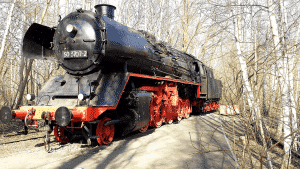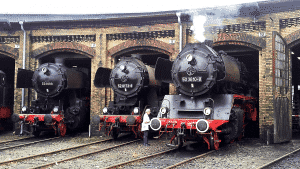
Details of DRB class 50
| Manufacturer: | various |
| Total length: | 22,940 mm |
| Numbering: | 50 001-50 3171 with gaps |
| Weight: | 86.9 t |
| Years of construction: | 1939-1948 |
| Top speed: | 80 km/h |
| Retirement: | 1987 |
| Fuel supply: | 8 t hard coal |
| Water supply: | 26.0 m³ |
| Number: | 3164 |
| Power: | 1186 kW |
| Boiler overpressure: | 16 bar |
| Interesting facts |
|---|
| The freight locomotives steam locomotive BR 50 belong to the type 1'E h2. They have 1 running axle independent of the main frame, and 5 coupled axles mounted in the main frame. The steam type is superheated steam and the locomotives have 2 cylinders. More interesting facts |
Steam locomotive DBR Class 50 - The production after the beginning of the war

